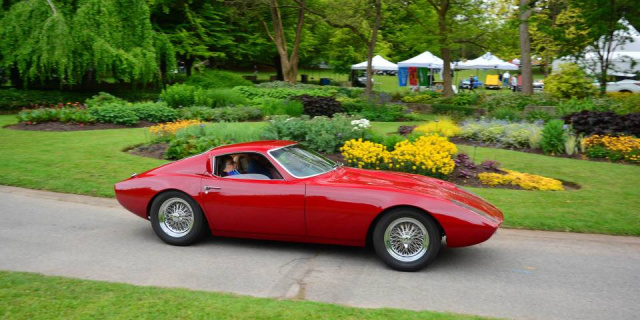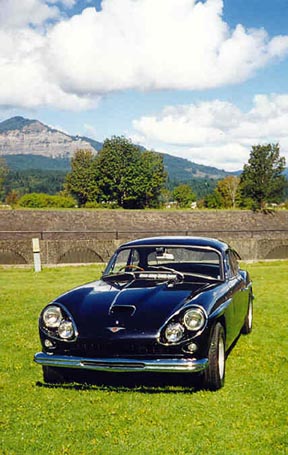
Story by Myles Kornblatt • Images courtesy the manufacturers
Fiberglass kit cars of the 1950s and ’60s hail from an era
when daydreams could be affordably molded into reality.
Many of them emerged from underdog companies
looking to strike it rich by mixing inexpensive, mass-produced
parts into a wi…
Read the rest of the story

wspohn
HalfDork
7/26/17 10:56 a.m.
I'm a fan - own or have owned Jensens (which didn't get a mention), TVR, Buckler and my American bodied MG http://www.rhodo.citymax.com/f/Jamaican_Article.pdf
We've got a Marcos 1600GT in the shop at the moment.
I know everything about fiberglass from my 1954 Motor Trend Manual of Building Plastic Cars.

And the GSM Dart and Delta from South Africa...Really want a GSM Delta.

wspohn
Dork
3/22/20 12:11 p.m.
Trans_Maro said:
We've got a Marcos 1600GT in the shop at the moment.
Early, or late production? I'd be a bit worried about the early ones that had wood chassis, although friend used to vintage race one. Dry rot could ruin your whole weekend....
I'll nominate the Lotus Elite as the most attractive fiberglass car (the suspension subassemblies were bonded into the GRP shells. Used to have a passel of them in my class at Laguna Seca - to be competitive they had to be pretty highly tuned, so the fastest ones were most likely to DNF, but they could be quick while they ran.

Sir-Mike, that is a sweet looking book that I have never seen.

ShawnG
UltimaDork
3/23/20 11:55 a.m.
In reply to wspohn :
Wood, it's long gone from our shop but it was plenty strong.
As long as it's not left outside in the elements with no glass in it and parked in tall grass, it's probably no worse than a similarly abused steel chassis.
As long as we are speaking of lost/forgotten marques of fiberglas production, there is the remarkable story of Intermeccanica of Italy which at the commission of Philadelphia radio personality, Ed Felbin, produced 50 of the classic SQUIRE SS100 Roadster from 1971-1973. Intermeccanica still exists in Vancouver, BC producing Porsche Speedster recreations.
The SQUIRE SS100 is an almost exact, full size replica of the 1937-1939 Jaguar SS-100. Bodies were all hand-laid fiberglass with a ladder type steel frame. Modified Alfa torsion bars suspended the front Ford Mustang A-arms with leaf springs & cylinder shock absorbers in rear. Power was the Ford Mustang/Maverick 250 c.i. (4.1 liter) straight Six hooked to either a C4 auto or 4 spd manual, 25 copies of each version.
I love showing my bit of the non-restored raggedy dog at different venues in Las Vegas and homestate VA where it's always a welcomed oddity.
Dart Hollywood



MadMac
New Reader
3/23/20 5:16 p.m.
Forgotten Fiberglass forgot the Saab Sonett. Mine was the same year and color as the one featured in this October 10, 2019 Car Catcher feature:
https://classicmotorsports.com/news/car-catcher-this-saab-sonett-iii-alternative-swedish-sports-car/

Gary
UltraDork
3/23/20 8:07 p.m.
Deserter GS/GT


These are probably the best Deserter examples in existence today. I think the maroon one belongs to Alex Dearborn, "father" of the Deserter going back to the Autodynamics days, and is pretty close to original intent. Beautiful vehicle. Mike's GS, the red one, is a heavily modified, mid-engined and well re-engineered screamer. Internally it doesn't bear much resemblance to the original Deserter GS design, but externally it looks the same as an original GS. Mike did a great job. Both are great cars!
Mike's GS (with body)
Mike's GS (sans body)
Got a letter yesterday from a new reader, who picked the magazine up in Canada. he sent a picture of what I think is a Falcon English Ford based special, that he built when he was a kid.
And of course, we still have our English Ford based special, the Tornado Typhoon.
We also still have our Meyers Manx, although the Deserter is a way cooler looking buggy.

wspohn
Dork
3/24/20 10:13 a.m.
You've seen this from me before, but it seems a logical place to add my GRP kit car, Fiberfab Jamaican (in this case on an MGA base with 93 Camaro V6 driveline).


In reply to The Staff of Motorsport Marketing :
In 1958Jack Baker took molds from Don Skogmo's D type Jaguar and birdcage Maserati ( still regionally competitive race cars) then put the results on a shortened Jaguar XK150 and created the Black Jack Special.
When I found the car post Vietnam it had been beaten up so badly it was far simpler to just make a mold and start with fresh pieces.
I did the same thing for a Devin. (De Mar mk 2) That one the body shop guy had charged the owner over $5000 late 70's dollars to straighten and paint it leaving it up to me to remount is. Then when at top speed on the front straight at Elkhart Lake the front bodywork pulled apart and went flying over 30 feet in the air. My pants got soiled. ( I was sorting it for the owner ) the replacement body taken from a mold off the pasted back together body weighed 118 pounds less. Since it was made from cloth rather than a chopper gun it was massively stronger too.
I also made molds from my XKE series 3 V 12 roadster ( except the rear tub ) In General it took me about a day to smooth out and triple wax the body part to prepare it to make a splash mold off it . A day or two to cure and then another day to wax and coat with PVA ( a release agent that washes off with water)
Had I kept all of those molds I'd be pumping out race cars like pop corn.
I've posted this many times before. This wasn't just my DD for a couple of years, but the only car I had running. Heater? Nope, de-mister? Nope, Seats? Well yes but I used to take them out and sit straight on the monocoque floor to save the one inch seat thickness for headroom.


Gary
UltraDork
3/25/20 10:06 a.m.
In reply to Adrian_Thompson :
Might this be you "back in the day?"

After seeing the Deserters above, I decided to see what Google could dredge up. I knew they were built on cut down VW frames, and were built in nearby Marblehead, but not much else. Imagine my surprize when a familiar name popped up in the post Marblehead period of Deserter history. Care to comment further, Gary?
ShawnG said:
In reply to wspohn :
Wood, it's long gone from our shop but it was plenty strong.
The original guys behind Marcos had worked on the DeHavilland Mosquito, which was one of the fastest piston engined planes of WW2 and mostly built out of plywood. They had plenty of experience of building lightweight and very strong structures out of plywood.

Gary
UltraDork
3/25/20 1:28 p.m.
In reply to stu67tiger :
My role was primarily as caretaker of the molds for a few years after Autodynamics and Formula Automotive in Marblehead, MA, pulled out of the business in the mid-seventies. Late seventies and early eighties were difficult years for kit car manufacturers. Although during my years with the molds we pulled a few bodies and other miscellaneous parts for people. In the mid-eighties I transferred everything to another caretaker in Ohio, who I think subsequently passed everything on to somebody in California. I heard there was talk about reviving the marque a few years ago, but don't know how that worked out. To my knowledge, Dearborn Automotive (Alex Dearborn) owns the rights to the name Deserter.
BoxheadTim said:
ShawnG said:
In reply to wspohn :
Wood, it's long gone from our shop but it was plenty strong.
The original guys behind Marcos had worked on the DeHavilland Mosquito, which was one of the fastest piston engined planes of WW2 and mostly built out of plywood. They had plenty of experience of building lightweight and very strong structures out of plywood.
A lot of the DeHavilland Vampire was also wood. The Vampire was the second jet aircraft to enter service for the RAF, and the first with a single engine as the Gloster Meteor was twin engine.

The address for the Elva distributor, Continental Motors Ltd, in Washington, DC is now a Rite Aid Drug Store. Back then, you didn't need much to be an automobile distributor.
In reply to MadMac :
I was going to make the same comment.

wspohn
SuperDork
3/30/21 10:17 a.m.
BTW, fibreglass didn't initially have the connotation of cheap kit cars about it. That came a bit later when the dune buggy thing happened. Back in the early days it was just an interesting new body material that the more creative manufacturers experimented with.
Jensen started doing it as early as 1954 and Lotus and TVR in the later 50s. This is my later Jensen model, also with GRP body. It was considerably lighter than the Interceptor, which used the same chassis with a steel body.















































